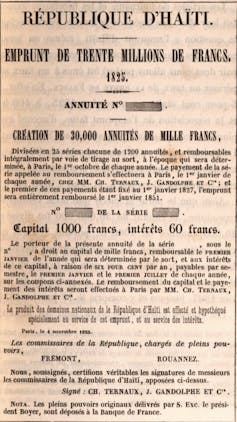A French propaganda engraving from 1825 depicts King Charles X bestowing freedom on a Black man kneeling before him in chains. ‘S.M. Charles X, le bien-aimé, reconnaissant l’indépendance de St. Domingue,’ 1825, Bibliothèque Nationale de France, Cabinet des Estampes, CC BY-SA
by Marlene L. Daut, Yale University
In 2002, Haiti’s former president Jean-Bertrand Aristide argued that France should pay his country $US22 billion.
The reason? In 1825, France extracted a huge indemnity from the young nation, in exchange for recognition of its independence.
April 17, 2025, marks the 200th anniversary of that indemnity agreement. On Jan. 1 of this year, the now-former president of Haiti’s Transitional Presidential Council, Leslie Voltaire, reminded France of this call when he requested that France “repay the debt of independence and reparations for slavery.” In March, tennis star Naomi Osaka, who is of Haitian descent, added her voice to the chorus in a tweet wondering when France would pay Haiti back.
Since we’re trying to repossess things, can Haiti get their money back? https://t.co/J20DEl17XQ
— NaomiOsaka大坂なおみ (@naomiosaka) March 17, 2025
As a scholar of 19th-century Haitian history and culture, I’ve dedicated a significant portion of my research to exploring Haiti’s particularly strong legal case for restitution from France.
The story begins with the Haitian Revolution.
France instituted slavery in the colony of Saint-Domingue on the western third of the island of Hispaniola – today’s Haiti – in the 17th century. In the late 18th century, the enslaved population rebelled and eventually declared independence. In the 19th century, the French demanded compensation for the former enslavers of the Haitian people, rather than the other way around.
Just as the legacy of slavery in the United States has created a gross economic disparity between Black and white Americans, the tax on its freedom that France forced Haiti to pay – referred to as an “indemnity” at the time – severely damaged the newly independent country’s ability to prosper.
The cost of independence
Haiti officially declared its independence from France on Jan. 1, 1804. In October 1806, following the assassination of Haiti’s first head of state, the country was split into two, with Alexandre Pétion ruling in the south and Henry Christophe ruling in the north.
Despite the fact that both Haiti rulers were veterans of the Haitian Revolution, the French had never quite given up on reconquering their former colony.
In 1814, King Louis XVIII, restored as king after the overthrow of Napoléon earlier that year, sent three commissioners to Haiti to assess the willingness of the country’s rulers to surrender. Christophe, crowned king in 1811, remained obstinate in the face of France’s exposed plan to bring back slavery. Threatening war, the most prominent member of Christophe’s cabinet, Baron de Vastey, insisted,“ Our independence will be guaranteed by the tips of our bayonets!”
In contrast, Pétion, the ruler of the south, was willing to negotiate, hoping that the country might be able to pay France for recognition of its independence.

A portrait of Alexandre Pétion. Alfred Nemours Archive of Haitian History, University of Puerto Rico
In 1803, Napoléon had sold Louisiana to the United States for US$15 million. Using this number as his compass, Pétion proposed paying the same amount. Unwilling to compromise with those he viewed as “runaway slaves,” Louis XVIII rejected the offer.
Pétion died suddenly in 1818, but Jean-Pierre Boyer, his successor, kept up the negotiations. Talks, however, continued to stall due to Christophe’s stubborn opposition.
“Any indemnification of the ex-colonists,” Christophe’s government stated, was “inadmissible.”
Once Christophe died in October 1820, Boyer was able to reunify the two sides of the country. However, even with the obstacle of Christophe gone, Boyer repeatedly failed to successfully negotiate France’s recognition of independence. Determined to gain at least suzerainty over the island – which would have made Haiti a protectorate of France – Louis XVIII rebuked the two commissioners Boyer sent to Paris in 1824 to try to negotiate an indemnity in exchange for recognition.
On April 17, 1825, Charles X, brother to Louis XVIII and the new French king, performed a sudden about-face. Charles X issued a decree stating that France would recognize Haitian independence but only at the price of 150 million francs – or nearly twice the 80 million francs the U.S. had paid for the Louisiana territory.
Baron de Mackau, whom Charles X sent to deliver the ordinance, arrived in Haiti in July, accompanied by a squadron of 14 brigs of war carrying more than 500 cannons.
His instructions stated that his “mission” was “not a negotiation.” It was not diplomacy either. It was extortion.
Amid the threat of violent war and a looming economic blockade, on July 11, 1825, Boyer signed the fatal document, which stated, “The present inhabitants of the French part of St. Domingue shall pay … in five equal installments … the sum of 150,000,000 francs, destined to indemnify the former colonists.”
French prosperity built on Haitian poverty
Newspaper articles from the period reveal that the French king knew the Haitian government was hardly capable of making these payments, as the amount was nearly six times Haiti’s total annual revenue. The rest of the world seemed to agree that the agreement was absurd. One British journalist noted that the “enormous price” constituted a “sum which few states in Europe could bear to sacrifice.”

A facsimile of the bank note for the 30 million francs that Haiti borrowed from a French bank. Lepelletier de Saint-Remy, ‘Étude Et Solution Nouvelle de la Question Haïtienne.’
Forced to borrow 30 million francs from French banks to make the first two payments, it was hardly a surprise to anyone when Haiti defaulted soon thereafter. Still, a subsequent French king sent another expedition in 1838 with 12 warships to force the Haitian president’s hand. The 1838 revision, inaccurately labeled “Traité d’Amitié” – or “Treaty of Friendship” – reduced the outstanding amount owed to 60 million francs, but the Haitian government was once again ordered to take out crushing loans to pay the balance.
It was the Haitian people who suffered the brunt of the consequences of France’s theft. Boyer levied draconian taxes in order to pay back the loans. And while Christophe had been busy developing a national school system during his reign, under Boyer, and all subsequent presidents, such projects had to be put on hold. Moreover, researchers have found that the independence debt and the resulting drain on the Haitian treasury were directly responsible not only for the underfunding of education in 20th-century Haiti, but also for the lack of health care and the country’s inability to develop public infrastructure.
A 2022 analysis by The New York Times, furthermore, revealed that Haitians ended up paying more than 112 million francs over seven decades, or $560 million – estimated between $22 billion and $44 billion in today’s dollars. Recognizing the gravity of this scandal, French economist Thomas Piketty has argued that France should repay at least $28 billion to Haiti in restitution.
A debt that’s both moral and material
Former French presidents, from Jacques Chirac to Nicolas Sarkozy to François Hollande, have a history of punishing, skirting or downplaying Haitian demands for recompense.
In May 2015, when Hollande became only France’s second head of state to visit Haiti, he admitted that his country needed to “settle the debt.” Later, realizing he had unwittingly provided fuel for the legal claims already prepared by attorney Ira Kurzban on behalf of the Haitian people, Hollande clarified that he meant France’s debt was merely “moral.”
To deny that the consequences of slavery were also material is to deny French history itself. France belatedly abolished slavery in 1848 in its remaining colonies of Martinique, Guadeloupe, Réunion and French Guyana, which are still territories of France today. Afterward, the French government demonstrated once again its understanding of slavery’s relationship to economics when it financially compensated the former “owners” of enslaved people.
The resulting racial wealth gap is no metaphor. In metropolitan France, 14.1% of the population lives below the poverty line. In Martinique and Guadeloupe, in contrast, where more than 80% of the population is of African descent, the poverty rates are 38% and 46%, respectively. The poverty rate in Haiti is even more dire at 59%. And whereas the gross domestic product per capita – the best measure of a country’s standard of living – is $44,690 in France, it’s a mere $1,693 in Haiti.
These discrepancies can be viewed as the concrete consequences of stolen labor from generations of Africans and their descendants.
In recent years, French academics have begun to increasingly contribute to the conversation about the longitudinal harms the indemnity brought to Haiti. Yet what effectively amounts to a statement of “no comment” has historically been the only response from France’s current government under President Emmanuel Macron.
Yet if recent reports prove accurate, on the bicentennial of the indemnity “agreement,” Macron plans to issue a “landmark statement” about France’s “colonial legacy,” along with several “memory initiatives,” designed to “keep the memory of slavery alive throughout the national territory, as in Haiti.”
But to me, the only initiative from France that would matter would be one detailing how it plans to provide economic recompense to Haitians.
This is an updated version of an article originally published on June 30, 2020.![]()

Marlene L. Daut, Professor of French and African American Studies, Yale University
This article is republished from The Conversation under a Creative Commons license. Read the original article.